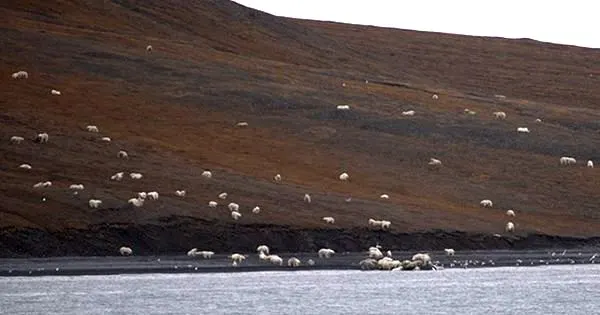Note: we are republishing this story which originally made the news in December 2019.
The sight of over 200 polar bears on Wrangel Island reminded tourists of grazing sheep as tourists and researchers watched from the vessel Akademik Shokalskiy, which was cruising along the shoreline of the Russian-controlled island in the Arctic Ocean.
The large number of polar bears had been drawn to the area by the scent of a whale carcass.
The bears arrived on or before September 19, and did not leave the area until the carcass was consumed a day or two later.
Capt. Rodney Russ of Heritage Expeditions, leader of the expedition, called the sight “one of those days I or anybody else with me will never forget.”
“We were cruising down the coast and saw a ‘herd’ or ‘convention’ of polar bears on or near the beach. There was a dead bowhead whale and we counted over 150 polar bears (of all ages, sexes, and sizes) that were either feeding or had been feeding on it in the immediate vicinity of the whale,” he wrote. “We launched the Zodiacs for a closer look and that is the memory we will all carry with us… there are no words to describe it. I share one photo in the hope that it will portray something of our experience.”

Photo Credit: Twitter/Planet Green
The Siberian Times reported that there were at least 230 polar bears in the area, with The Times writing that some tourists stated that at a distance, the bears resembled grazing sheep.
Wrangel Island, a 2,900-acre nature reserve between the Chukchi Sea and East Siberian Sea, has the highest density of polar bear dens on earth, with as many as 400 mother bears raising their young on the island during winter.
 Photo Credit: Twitter/Planet Green
Photo Credit: Twitter/Planet Green
More polar bears have used Wrangel Island during the summer in recent years due to the diminishing ice pack in the surrounding areas.
Wrangle Island is called the “Galapagos of the North,” and is believed to be the last place on earth to have sustained woolly mammoths.
Sources: Men’s Journal



